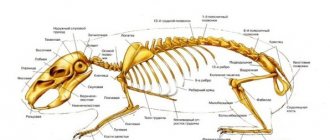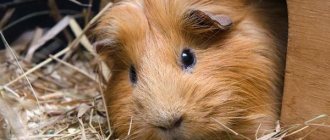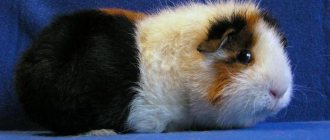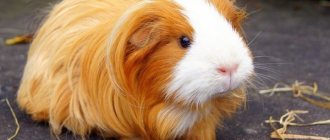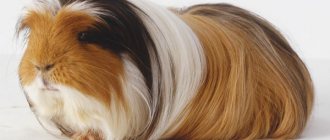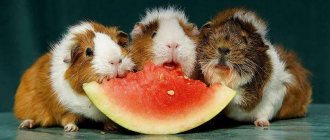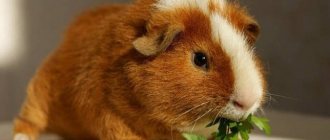How old is the breed?
In general, guinea pigs have been around for thousands of years. There are records indicating that guinea pigs were domesticated as early as 5000 BC in South America. They were brought to Europe by Spanish sailors for use as exotic pets in the 1500s. The earliest written record indicating their use as pets in Europe dates back to 1547 AD. The earliest written records of guinea pigs in the West date back to 1554 AD, although they have been mentioned in the Caribbean since around 500 BC.
As for the Abyssinian breed specifically, it is difficult to determine exactly when the first appearance occurred. Abyssinians are considered one of the oldest breeds, but it is difficult to establish the exact date of their appearance. It is possible that they first appeared in Europe between 1200-1550 AD, when guinea pigs were first actively bred to produce new species suitable for exotic pets. To read about other studies attempting to determine the origins of the Abyssinian breed, visit the British Cavalry Council.
Standard
The number and location of rosettes is a decisive factor in determining the purity of an animal's breed.
Their number varies, but should not be more than 10-12.
There are 4 main rosettes along the back, 4 more in the back of the body, and symmetrically located rosettes on each shoulder.
In addition, the pig must have a pronounced “collar” and “whiskers”.
The shape of the ridges formed by the rosettes is also important: they should be smooth, vertically directed, without kinks.
The good quality of the combs determines the hardness of the animals' fur; Females have slightly softer fur than males.
The length of the fur is approximately 3 - 3.5 cm. The body is square, the muzzle is blunt.
The colors of pigs are very diverse, but are divided into two main groups:
- agouti - close to the original, wild color of rodents;
- self - plain white, red, black, cream;
- In addition, there are tortoiseshell pigs
- and the most common - piebald.
How did the Abyssinians get their name?
The naming of modern common guinea pig breeds was made by various breeding organizations that were created by guinea pig lovers. Today, several organizing groups are the British Cavalry Council in England and the American Rabbit Breeders Association in America.
The first Abyssinian guinea pig was identified in Europe, but the British Maritime Council was not formed until 1977, so they were not responsible for naming it. During the Victorian era (1837–1901), there was literature describing guinea pigs with pink fur. So who actually gave it its name when it first appeared? We do not know.
So why call him an Abyssinian if he is clearly not from Abyssinia? Well, this is also a subject of debate.
When guinea pigs were first bred and sold as exotic pets in Europe, it seemed that exotic names made guinea pigs sell better. It is possible that Abyssinians got their name because guinea pigs were transported to Europe on ships used in the Guinean slave trade, and as such were sold as coming from the Abyssinian region of Africa. But this is speculation and there is no evidence or documentation to support this claim. Perhaps the name sounded exotic, so someone decided to use it to increase interest and sales.
What type of fur do they have?
The Abyssinian's coat is dense and rough. The coat is one to one and a half inches long, so it is considered a short-haired breed. They usually have 4 rosettes (or curls of hair) on their back, a rosette on each hip, one on each shoulder, and two on the rump. Of course, this may vary.
The rosettes form ridges at the junction with each other. They also have hair around their mouths that form "whiskers". For show purposes, an Abyssinian should have a minimum of 8 rosettes, but 10 is ideal. For demonstrating standards, see the American Rabbit Breeders Association.
What color are Abyssinian guinea pigs?
There are many varieties of guinea pig colors, and Abyssinians can be any of these colors. Click here to see descriptions of the different colors. In addition to the regular Abyssinian coat, there are satin Abyssinian guinea pigs, which have a sheen or sheen to their coat.
At what age can Abyssinian guinea pigs breed?
A male Abyssinian guinea pig (boar) can successfully mate at 3 weeks of age. The female (sow) can be sexually mature and become pregnant at 4 weeks of age.
What is their gestation period?
The gestation period is about 2 months, from 59 to 73 days. Female guinea pigs have a high mortality rate due to problems with pregnancy. It is estimated that 20% of women die during pregnancy. The risk of death or complications increases with age. Pregnancy after 8 months poses a greater risk of problems or death than pregnancy at a younger age.
What is the average litter size?
There are from 1 to 6 cubs in a litter, with an average of 3. The record for the largest litter is 17 babies, but it was not an Abyssinian. (Guinness Book of Records. Guinness World Records Ltd. 2007. p. 127).
How do you care for a baby Abyssinian guinea pig?
Unlike many other baby animals, baby guinea pigs are not born helpless or with their eyes closed. In fact, guinea pigs are born well developed and therefore generally do not require much care. Baby guinea pigs are born ready to run. They are born with fully developed teeth and can eat solid food after a couple of days (Merck Veterinary Manual recommends eating solid food after 5 days).
They usually nurse from their mother for about 3 weeks, but if a guinea pig separates from its mother or its mother dies, you can feed them regular food. The newborn can be fed granulated puree or a restorative type nutritional supplement powder (such as Critical Care brand) mixed with canned pumpkin. They don't need their mother's milk at all, so there's no need to add milk or try to bottle feed.
Abyssinian colors
The main requirement for color is color saturation, brightness and shine of the coat. Guinea pigs can be:
- Red,
- Black,
- Two-color,
- tricolor,
- Agouti,
- Cherepakhov,
- White-gray,
- Dirty white
- White,
- Selfie.
White animals can have both dark and red eyes. The most common colors are red and white and white and black. All motley animals have patches of red or black hair all over their bodies. If there are more red hairs, then the pigs are classified as light; if there are more black hairs, then they are classified as dark. Abyssinian tortoiseshells should have clearly defined boundaries between their black and red markings.
Tortoiseshell, as well as the original variegated color, are very rare in the breed today.
According to the standard, tri-colored or white-tortoiseshell animals must have pronounced spots of each color, located in a chaotic order. Chocolate color is allowed instead of black. The solid color of the selfie is officially recognized only by the English standard and allows for black and red color forms. Roan, blue roan and strawberry colors are rarely found in animals. Typically, animals of these colors cost five to seven times more than ordinary purebred Abyssinians. Often, breeders pass off colors that are similar to them, but less expensive, as valuable. Under the photo you can see the description of the color as variegated, but in reality the color is tricolor and has blurred boundaries of the spots.
Novice breeders and hobbyists are not always able to see the differences between colors and pay a lot of money for a completely ordinary animal.
How long do Abyssinian guinea pigs live?
The lifespan of Abyssinian guinea pigs is the same as most other guinea pigs. Average life expectancy is 5-7 years. But, like all creatures, it's just average. Lifespan depends on many factors - environment, diet, individual genetics, etc. Some will not live past 5 years, while others will live much longer. A guinea pig from Nottinghamshire, England, named Snowball, lived to be 14 years, 10 months and 2 weeks. (Guinness Book of World Records, 2013, edited by Craig Glenday, p. 263)
What are their specific health problems?
Like all guinea pigs, if Abyssinian guinea pigs do not get enough vitamin C in their diet, they can develop scurvy. Regarding Abyssinians specifically, a 2010 study by David Williams and Anne Sullivan found that Abyssinians are more likely to have vision problems than other breeds, particularly microphthalmos (small eyes often leading to blindness) and cataracts.
In addition to the increased risk of eye diseases, Abyssinians as a breed have a higher susceptibility to developing diabetes mellitus and ovarian cysts.
What is the Abyssinian temperament like?
Abyssinian guinea pigs are not very different from other guinea pig breeds in terms of temperament, but they are often considered more "mischievous" than other breeds. They tend to be a little more energetic than other breeds, but are not vicious. Abyssinians tend to be a little louder than other breeds and chatter during the day. Of course, each guinea pig is individual, so it is difficult to group them all and say: “All Abyssinians...”. But, as a rule, Abyssinians are very sociable, but do not care about being hugged and held in the same way as other guinea pig breeds.
Are Abyssinian Guinea Pigs Smart?
Well, “intelligence” has many aspects, so there is no one answer. What we do know from various studies is that guinea pigs are generally quite intelligent creatures. They are good at associative learning - they easily learn to associate one thing with another (for example, they hear the rustling of a bag and associate it with food). Research has shown that they are poor at solving abstract problems, but are good at solving navigational and spatial problems.
Prices
The cost of purebred babies depends on the data and further purpose of the pig. If an animal is sold without a pedigree, then its cost may not exceed 1000 rubles. If the pig meets breed standards, but it is clear from its movements and external appearance that its purpose is to please its owners, then you can buy a pet for 1000–1500 rubles. Pigs for breeding are sold for 1500-2000 rubles. If the pet is suitable for exhibitions, then its cost is from 2500 to 3500 rubles.
What is the character of Abyssinian guinea pigs?
Again, each guinea pig is different and has its own personality. However, some of the words that Abyssinian guinea pig owners use to describe their Abyssinian guinea pig are "mischievous", "vocal", "cute", "gentle", "curious", "loyal", "brave", "independent". , and "alive".
Are Abyssinians suitable for small children?
Absolutely. Abyssinians are gentle and kind. Of course, you need to teach young children how to properly handle Abyssinians, because if they feel hurt, or if they feel threatened or insecure, they may react with aggression.
What kind of housing do Abyssinian guinea pigs need?
Abyssinians are no different from other breeds of guinea pigs. They need enough space to move around, a place to hide, where they can feel safe. They need a cage with a smooth bottom or living area so they don't have foot problems. At a minimum, one guinea pig should have a cage that is at least 2 square feet, but many marine organizations recommend at least 7.5 square feet of space (30" x 36"). A large area is ideal. For ideas on how to build your own guinea pig cage, see Make Your Own Guinea Pig Cage.
What do Abyssinian guinea pigs need in their daily diet?
Again, Abyssinians are no different from other breeds. They need an adequate supply of grass hay, which should always be available. Ideally, they should get 75% of their diet from grass hay such as timothy hay. They also need high quality guinea pig kibble (1/8 - 1/4 cup per guinea pig per day), fresh, clean water (minimum 5 ounces per day), adequate amounts of vitamin C (30-50 mg per 2 pounds). animal per day), fresh vegetables (daily) and fresh fruits (at least 1-2 times a week). See the What Guinea Pigs Eat infographic.
Do Abyssinian guinea pigs need grooming?
Unlike long-haired breeds, Abyssinian guinea pigs do not require much grooming. An Abyssinian usually doesn't need to be bathed, but some owners do bathe them from time to time.
Do Abyssinian guinea pigs smell like ferrets?
No. They do not have scent glands like ferrets and do not have a distinct scent. If your guinea pig smells, take a close look at his cage and environment to make sure it is clean.
Do Abyssinian Guinea Pigs need exercise?
Yes! Never leave your guinea pig in a small cage for long periods of time. Give them time to run freely indoors or outdoors. They need daily exercise.
Can Abyssinian guinea pigs live alone?
By nature, guinea pigs are social animals, and the Abyssinian breed is no exception. Even if you give him a lot of attention during the day, it may not be enough. It is often a good idea to keep at least two guinea pigs (just make sure they are the same sex!). However, sometimes having more than one isn't possible, and if you live alone, you'll want to make sure to provide plenty of social interaction.
Do Abyssinian guinea pigs need toys?
Although it is not absolutely necessary, some owners like to provide toys. Toys help reduce boredom and provide stimulation. However, you don't have to spend money on toys. You can take an old toilet paper roll or paper towel roll, fill it with hay and put it in the cage. You can also use other chewable items, such as small paper bags or socks. You can let them play with the balls. Just make sure they are too big to swallow and not made of poisonous material, as they can be chewed.
You can provide small rubber or plastic balls, just watch regularly for signs of chewing. If it gets chewed or worn out, replace it. You can take cardboard or wood and build a maze out of it. Take an empty cardboard tube, similar to an oatmeal container, cut out the ends and make tunnels. The options for homemade toys are endless. Just use your imagination.
What are their sleeping habits?
Abyssinian guinea pigs, like most guinea pigs, are active most of the day. A guinea pig kept alone is active 20 hours a day or more with short periods of sleep. They are sometimes active in their sleep when they are walking, but are somewhat withdrawn. Some owners brush them 1-2 times a week with a soft brush, but when it comes to maintenance, they are low maintenance.
Care and maintenance
The Abyssinian pig is the best choice for keeping in the house. To prevent your pet from getting sick, you need to properly care for it. If the owner is attentive and caring, then the animal will always be clean, well-fed and healthy.
Arrangement of the cage
The size of the cage should not be small so that the pig can move freely. The length of the front and back walls is at least 1 m. It is better to add various devices to the house:
- Salt and mineral stones necessary for improving digestion and regular grinding of the guinea pig's teeth;
- a hay box for fresh hay, attached to a certain side of the cage;
- drinking bowl and feeder made of non-toxic materials;
- running wheel, climbing ladder;
- a special house for storing food supplies and resting your pet.
How to show an Abyssinian guinea pig?
Contact organizations that host guinea pig shows. For example, in America one of the organizations is the American Cavalry Breeders Association. See what they look for when rating an Abyssinian on their shows. The ACBA has an article detailing the Abyssinian judging criteria here. The American Rabbit Breeders Association maintains a list of all shows sanctioned by their organization here. Sometimes local organizations host shows (such as a 4H group or a county fair). They tend to be less competitive and less rigorous than regional, state or national shows. Contact the organizers and get exact information about what you need to participate.
How much do Abyssinian guinea pigs cost?
Sometimes you can get a free Abyssinian guinea pig, so regularly check classified ads sites like Craiglist or Petfinder to find an owner who wants to bring their Abyssinian home. Additionally, you can expect to pay between $15 and $75 for an Abyssinian guinea pig. Of course, it all depends on where you live or where you source from. Pet stores in the Midwest sell them for about $35. I've seen breeders sell them for $10-$15. You can get them from pet stores, breeders, classifieds websites, rescue centers or local animal shelters.
What is the monthly cost of caring for an Abyssinian guinea pig?
On average, the initial installation cost is around $100-200. For the initial setup, this means purchasing a cage, a water bottle, hay, pellets, a feeder, bedding, a hutch or something to hide in, vitamin C supplements, toys, and a brush or comb. Of course, you can save money by building your own cage (see Make Your Own Cage for some cheap ideas!).
In terms of monthly maintenance costs, you can expect to spend $20-$40 per month per guinea pig on kibble, vegetables, hay, bedding, and vitamin supplements. Toys and accessories are optional and are not included in this calculation. Visiting a veterinarian will incur additional costs, and the costs vary too widely to provide a reliable estimate. To see what other owners say they spend on their guinea pigs, read the posts here.
Abyssinian guinea pigs in literature
Tears of Lilies Amazon Editors' Favorite Book - Books of the Year 2014. The story of one woman's journey with her pets, including Squeaky, her beloved golden Abyssinian guinea pig. Pete Through the Lens of Our Four-Legged Friends This book documents "A Day in the Life" of several pets, including Gus, an Abyssinian guinea pig with an artistic vision. The author attaches cameras to the pets so we can see his pet's daily life through the pet's eyes. Pig Talk Written in 1963, this children's story details the relationship between Cécile, a French girl, and Jean-Pierre, an Abyssinian guinea pig. Then-Pierre at the Circus Continuation of the above story, written in 1970. Thearawan A book by Beatrix Potter about a miniature circus, written for older children. With Abyssinian guinea pig ribbon.
Tips for feeding large dogs
How to properly feed young puppies Why do dogs eat grass on the street and regurgitate it?
Salad recipes for dogs: can you give them to your puppy?
Taurine for cats: is it important in nutrition for cats? Summer recipes for your cat. How to feed a cat in summer?
4 Homemade Dessert Recipes for Cats
9 Omnivores: Meet Them Here
What to feed a pregnant cat?
222

